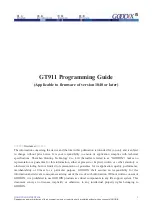
GOODIX CONFIDENTIAL
Reproduction and/or distribution of this document in whole or in part is strictly prohibited without written consent of GOODIX.
3
1. Description on Interface
GT911 interfaces with the host via 6 pins: VDD, GND, SCL, SDA, INT and RESET.
The INT pin of the host can be rising/falling-edge Triggered. In addition, when INT is in input state, the host
should set INT to be floating, with no internal pull-up or pull-down; the host controls the RESET pin of the GT911
by outputting high or low level. To ensure reliable reset, it is recommended that RESET pin outputs low for longer
than 100
μ
s.
GT911 communicates with the host via standard I
2
C interface, with a maximum transmission rate of 400K bps.
When the host communicates at rates exceeding 200K bps, it is required to pay special attention to the resistance of
the external pull-up resistor of I
2
C interface to ensure the edges of SCL and SDA are steep enough. GT911
invariably serves as slave device in communication and its I
2
C device address consists of 7 device address bits and
1 Read/Write control bit. The high 7 bits are device address while bit 0 is Read/Write control bit. GT911 supports
two slave device addresses which are shown below:
7 bit address
8 bit write address
8 bit read address
B
B
x
0
A
B
x
0
D
5
x
0
9
2
x
0
8
2
x
0
4
1
x
0
Upon each power-on or reset, it is required to select I
2
C address using INT pin. For specific configuration
method, please refer to section 4.1 and section 4.2.
2. Communication Timings
2.1 Timing for Write Operation
S: Start condition.
Address_W: slave device address with Write control bit.
ACK: Acknowledgement signal.
Register_H, Register_L: 16-bit register address from which Write Operation starts
Data_1 to Data_n: Data bytes 1-n.
E: Stop condition.
After setting the starting register address for Write operation, it is allowed to write one or more bytes at a
time. GT911 will automatically increase the address of register and store the data bytes in sequence.




































